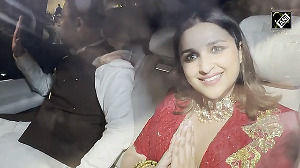What is Navratri?
Navratri, the celebration of nine ratris or nights, is dedicated to India's goddesses and chiefly to the goddess of Shakti (an incarnation of Parvati, consort of Shiva), who goes by several names Maa Amba who rides a tiger, Mother Durga astride a lion or Chamundeshwari who slays a buffalo.
It is a festival which celebrates the all-pervading power of the divine goddess or Mother shakti who destroys evil.
A time to express gratitude to the goddessesThe first three nights are devoted to the goddess of action and energy. Her different forms -- Kumari, Parvati and Kali -- are worshipped during these days.
Lakshmi, the goddess of wealth, is worshipped for the next three days in her various manifestations as the goddesses of peace, plenty and bliss.
On the fifth day -- Lalita Panchami-- the blessings of Saraswati are requested. She is worshipped on the last three days of Navratri. Saraswati is the goddess of the spiritual knowledge and the knowledge that frees us from the bind of this materialistic world.
Legends of Navratri
Like with all Hindu festivals, a range of legends centre around Navratri.
In North India it is believed that Mahishasura, the mighty demon with the power to change into a buffalo, obtained a boon from Brahma that he could not be killed by man. Mahishasura set out to conquer the three worlds of heaven, earth and hell and drove away Indra and other deities from their kingdom.
To protect the world from his atrocities the trinity of Brahma, Vishnu and Shiva united their powers to give birth to a female warrior-goddess Durga.
Dazzled
From Eastern India comes the legend of Daksha, the king of the Himalayas and his beautiful and virtuous daughter, Uma, who wished to marry Lord Shiva since her childhood.
However, when Shiva finally came to marry Uma, the tiger-skin clad groom displeased Daksha. Angry at her choice, he broke off all contacts with his daughter and son-in-law.
Uma was so incensed with her father's rude behavior that she immolated herself causing Shiva great grief. But she took birth again and won Shiva once more as her groom and peace was restored. It is believed, ever since, Uma comes every year with her four children Ganesh, Kartik, Saraswati and Lakshmi and two of her best friends or sakhis named Jaya and Bijaya, to visit her parents' home during Navratri.
How is Navratri celebrated all over India?
In North India fasting is an important part of the proceedings. A special celebration occurs on the eighth day or Ashtami when fasts are broken. Ashtami is a day of puja for young girls who are treated as the goddesses or Kanjak Devis.
Gujarat marks Navratri with large-scale festivities. Pulses and other kinds of seeds are sown in special pots on the first day of the festival. These pots are watered for nine days and by the ninth day the seeds have most certainly sprouted. A Garba deep is lit around which a garba or dandiya is conducted.
In South India, the nine days are a day of dolls. Images of gods and dolls are set up in each home. Pujas and archanas (chants) are conducted. This display is known as Bommai Kollu -- bommai means dolls and kollu means displaying.
Compiled by Rediff News Bureau






 © 2025
© 2025